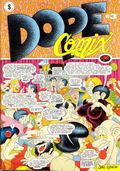dope

dope
Kitchen Sink 1978-84
By 1978, the pot-smoking, LSD-tripping hippie era had long since passed and the counterculture revolution had failed to achieve its big-picture objectives regarding societal norms and government policies and operations. But the use of illicit drugs by the American public actually skyrocketed in the ’70s, with historical data from Gallup polls and surveys indicating a 600% increase in adults who said they had tried marijuana from 1969 to 1977. Illegal drug use was glamorized in various movies and popular rock music, and touted by comedians like George Carlin and Cheech and Chong. That year, the raunchy, drunken frat flick Animal House was the top-grossing movie in America and the pothead cult classic Up in Smoke earned top 10 ticket sale honors.
In that same year, Kitchen Sink launched the comic book series Dope Comix. The first issue sported a retro-charming Leslie Cabarga front cover featuring costumed sewer bugs engaged in pot smoking torture. The stories in the debut issue included “Quaalude 714,” “The Great Marijuana Debate,” “Fun With Dope,” and “Little Bungo in Reefer Land.” At first glance, a typical citizen from the ’70s might conclude that Dope Comix was being marketed to druggies and junkies. Which was actually true. But Dope Comix was clearly not designed to celebrate the joys of recreational drug use. It was designed to scare the shit out of anyone who used illicit drugs and stereotype those types of people as brain-dead morons of the lowest order.
As long as readers are forewarned that Dope Comix is essentially anti-drug propaganda, then it can be taken at face value and evaluated for what it is. Unfortunately, like most anti-drug propaganda, Dope Comix talks down to its audience and its unrelenting sermonizing renders it predictable and often boring. Not that there isn’t a smattering of laughs to be found in this series, but most of them are quite sobering. Unlike Cocaine Comix, which mixes precautionary testimonials with lighthearted parody, Dope Comix just layers one tale after another about burnt-out hippies, suffering junkies and bad drug trips.
Dope Comix is also guilty of painting all illicit drug use with a broad, condemning brush. Whereas a significant majority of ’60s counterculture intelligentsia had proselytized that some drug categories were dangerous (speed, heroin, cocaine) while others were relatively benign or even beneficial (pot, LSD), Dope Comix depicts them all as a menace to society. The overwhelming negativity seems unbalanced and misplaced in what is purportedly a counterculture comic. The only non-condemning story in the entire series is hidden at the end of the third issue; an inspired romantic adventure by Doug Hansen, “A Night in a Head Shop.”
Ironically—and not accidentally—the front cover art for Dope Comix features exceptional comic artists, from John Pound and Jay Lynch to Rand Holmes and Charles Burns. A cursory review of the cover art does not reveal the anti-drug evangelism of the content; in fact, the ornate John Pound cover for Dope Comix #2 appears to celebrate the serene virtues of a little hashish toking. This amounts to false advertising by Kitchen Sink, as High Times aficionados would likely buy the comic based on the title and the cover art, only to discover the “comix” within were worse than mom’s anti-drug brainwashing tactics.
Of course, underground cartoonists had been exposed to the perils of illicit drug use for years, either through their own experimentation or by witnessing the exploits of others. They certainly had plenty of dire and pathetic drug-related stories to convey, but the sinister connotations that course through every vein of this series result in a very narrow and one-sided presentation of “dope” use in America.





